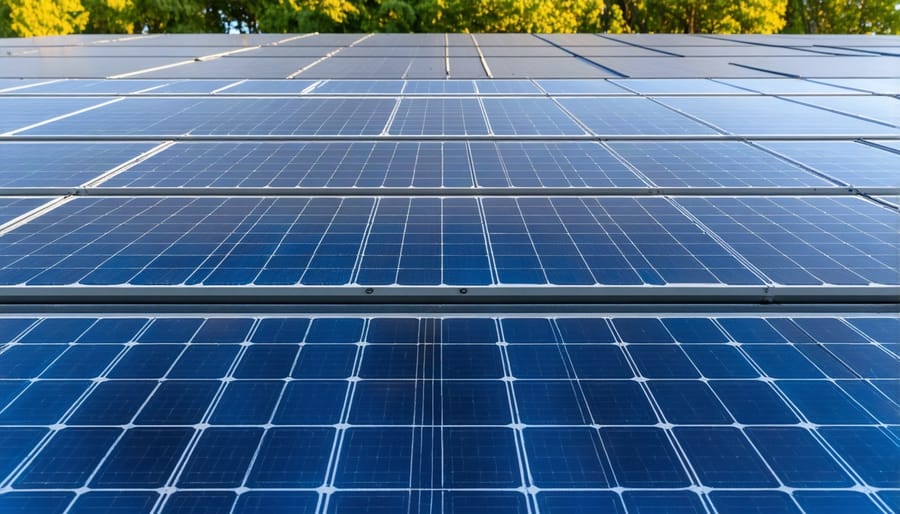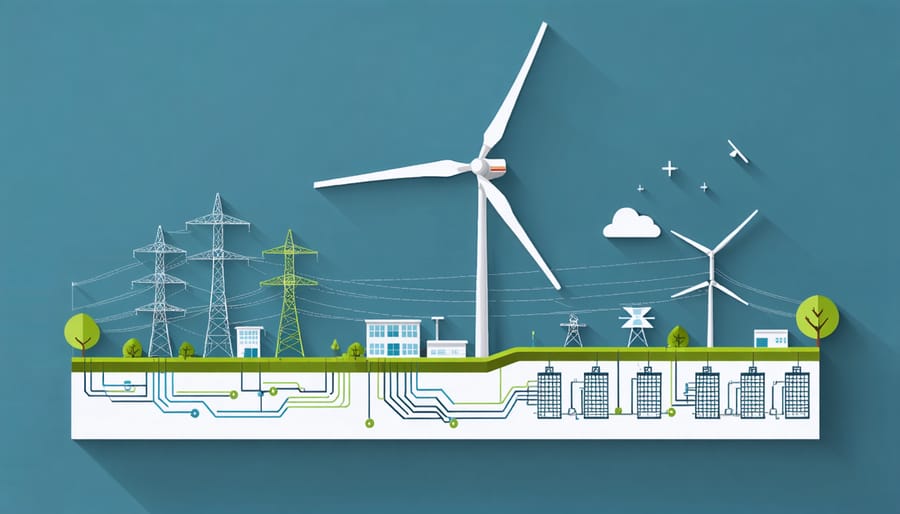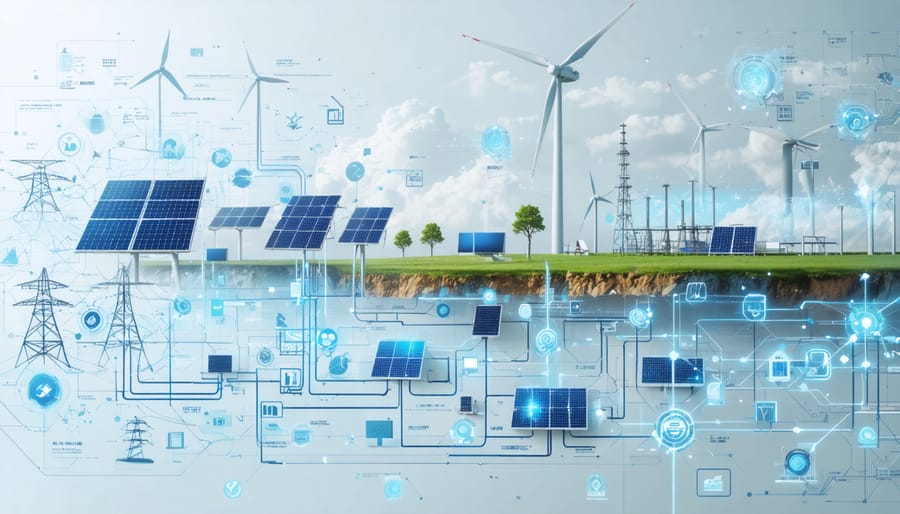The global transition to renewable energy stands at a critical inflection point, with technological innovations and falling costs revolutionizing how we power our world. As construction professionals integrate smart grid technology with sustainable power sources, five key renewable resources emerge as foundational elements of modern energy infrastructure: solar, wind, hydroelectric, geothermal, and biomass energy. These technologies not only offer compelling alternatives to fossil fuels but also present significant opportunities for construction firms to deliver cutting-edge energy solutions that meet increasingly stringent sustainability requirements. Understanding their unique characteristics, implementation challenges, and integration methods has become essential for industry professionals tasked with designing and building the energy systems of tomorrow. This technical analysis examines how these renewable resources can be effectively deployed within commercial and industrial applications, focusing on practical implementation strategies that maximize efficiency while ensuring reliable power delivery.
Solar Power: Advanced Integration Solutions
Photovoltaic System Integration
Photovoltaic system integration with building management systems (BMS) represents a critical advancement in renewable energy deployment. The integration process involves connecting solar PV arrays with sophisticated monitoring and control systems that optimize energy generation, storage, and consumption within buildings.
Modern PV integration relies on smart inverters that communicate directly with the BMS through standardized protocols such as Modbus or BACnet. These systems enable real-time monitoring of power output, system performance, and environmental conditions while facilitating automated responses to varying energy demands.
Key components of an integrated PV system include:
– Power optimizers for maximum energy harvest
– Smart metering infrastructure
– Energy management controllers
– Data acquisition systems
– Grid interaction interfaces
The integration architecture typically follows a hierarchical structure, with individual PV components reporting to a central management platform. This allows facility managers to implement advanced features such as demand response, peak shaving, and automated load shifting based on solar generation patterns.
System efficiency is further enhanced through predictive analytics and machine learning algorithms that optimize energy flow based on historical usage patterns, weather forecasts, and time-of-use electricity rates. Modern installations achieve integration efficiencies of up to 98% through precise monitoring and control of DC-to-AC conversion processes.
For optimal performance, PV systems should be designed with scalability in mind, allowing for future expansion and technology upgrades without significant reconstruction of the existing infrastructure.

Energy Storage Solutions
Effective energy storage solutions are crucial for maximizing the potential of renewable energy systems. Modern battery technologies, particularly lithium-ion systems, have revolutionized how we capture and utilize renewable power. These advanced storage systems now achieve up to 85-90% round-trip efficiency, significantly improving the economic viability of renewable energy projects.
Smart inverter technologies play a vital role in optimizing storage performance. These sophisticated devices enable seamless switching between power sources while maintaining stable voltage and frequency levels. Through advanced monitoring and control algorithms, smart inverters can predict energy demand patterns and adjust storage cycling accordingly, extending battery life and improving overall system efficiency.
The integration of battery management systems (BMS) with building automation platforms has become increasingly important. These systems monitor critical parameters such as state of charge, temperature, and voltage levels in real-time, ensuring optimal performance and preventing potential failures. Modern BMS solutions can also facilitate demand response programs, enabling buildings to participate in grid stabilization efforts while generating additional revenue streams.
For construction professionals, understanding the spatial and structural requirements of these storage systems is essential. Contemporary battery installations typically require 0.5-1 square meters per 10kWh of storage capacity, with adequate ventilation and temperature control systems. The implementation of proper safety measures, including fire suppression systems and thermal runaway protection, is crucial for compliance with building codes and insurance requirements.
Wind Energy: Grid-Scale Implementation
Onshore and Offshore Solutions
The strategic placement of wind turbines presents distinct challenges and opportunities in both onshore and offshore environments. Successful wind power integration requires careful consideration of site-specific factors and infrastructure requirements.
Onshore installations benefit from easier accessibility and lower construction costs but face limitations in available land and potential community resistance. Solutions include advanced noise reduction technologies, visual impact mitigation through strategic placement, and smart grid integration systems that optimize power distribution during peak periods.
Offshore wind farms offer higher energy yields due to consistent wind patterns and fewer physical obstacles. However, they demand specialized construction techniques, corrosion-resistant materials, and robust submarine cable networks. Recent innovations in floating foundations have expanded potential installation sites beyond shallow waters, while automated maintenance systems reduce operational costs.
Both environments require sophisticated monitoring systems and grid stabilization technologies. Modern wind farms incorporate advanced SCADA systems, predictive maintenance protocols, and energy storage solutions to ensure reliable power delivery. The choice between onshore and offshore deployment ultimately depends on factors including geographical conditions, grid infrastructure capacity, and project economics.

Smart Grid Connectivity
Smart grid connectivity represents a crucial aspect of modern renewable energy integration, enabling efficient power distribution and management across diverse energy sources. Wind farms, in particular, require sophisticated grid connection systems to maintain stability and reliability. These systems incorporate advanced power electronics, including voltage source converters (VSCs) and FACTS devices, which help regulate power flow and maintain grid frequency.
The integration process involves multiple technical components, including transformers, switchgear, and protection systems, all working in concert to ensure seamless power delivery. Modern wind farms utilize SCADA systems for real-time monitoring and control, allowing operators to optimize performance and respond quickly to grid demands.
Grid codes and compliance requirements play a vital role in wind farm connectivity. These standards ensure that wind farms can provide essential grid support services, such as reactive power compensation and fault ride-through capability. Advanced forecasting systems are integrated into the grid infrastructure to predict wind patterns and adjust power output accordingly.
Energy storage solutions, particularly battery systems, are increasingly being incorporated into wind farm grid connections. These systems help smooth out power fluctuations and provide auxiliary services to the grid, enhancing overall system reliability and flexibility. The implementation of smart meters and advanced communication protocols enables better coordination between wind farms and grid operators, facilitating efficient power dispatch and management.
Hydroelectric Power: Modernization and Integration
Smart Control Systems
Modern hydroelectric facilities rely on sophisticated control systems that optimize power generation while ensuring operational safety and efficiency. These smart systems integrate real-time monitoring, predictive analytics, and automated response mechanisms to manage water flow, turbine performance, and grid synchronization.
Advanced SCADA (Supervisory Control and Data Acquisition) systems form the backbone of these operations, continuously collecting data from thousands of sensors throughout the facility. These sensors monitor critical parameters including water levels, flow rates, turbine speeds, and generator outputs. Machine learning algorithms analyze this data to predict maintenance needs and optimize generation schedules based on demand patterns and environmental conditions.
Smart gates and automated spillway controls enable precise water management, crucial for both power generation and flood control. These systems can automatically adjust to changing conditions, maintaining optimal reservoir levels while ensuring downstream environmental flow requirements are met.
Grid integration features allow hydroelectric facilities to respond rapidly to demand fluctuations, providing essential grid stability services. Advanced control systems can seamlessly transition between generation modes, from base load to peak shaving, maximizing the facility’s value to the grid network.
Recent implementations have shown that smart control systems can increase operational efficiency by up to 15% while reducing maintenance costs by 25%.

Grid Stability Solutions
Hydroelectric power plays a pivotal role in maintaining grid stability, offering unique advantages that complement other renewable energy sources. Unlike intermittent solar and wind power, hydroelectric facilities can rapidly adjust their output to match demand fluctuations, providing essential load-following capabilities for the power grid.
Modern pumped storage hydroelectric systems serve as large-scale energy storage solutions, effectively functioning as giant batteries for the electrical grid. During periods of excess power generation, these systems pump water to elevated reservoirs, storing potential energy that can be released when demand peaks or other renewable sources experience temporary shortfalls.
According to industry data, hydroelectric facilities can achieve full power output within minutes, compared to hours for traditional thermal power plants. This quick-response capability proves invaluable for grid operators managing the integration of variable renewable energy sources.
The International Hydropower Association reports that pumped storage hydropower accounts for over 94% of installed grid-scale energy storage capacity worldwide. This technology’s proven track record and reliability make it an essential component of renewable energy integration strategies, particularly in regions with aggressive clean energy targets.
For construction professionals, understanding hydroelectric power’s stabilizing role is crucial when planning large-scale renewable energy projects or upgrading existing power infrastructure.
Biomass Energy: Sustainable Implementation
Combined Heat and Power Systems
Combined Heat and Power (CHP) systems represent a highly efficient approach to energy generation, capturing waste heat from power production for useful purposes such as space heating, domestic hot water, or industrial processes. In commercial and industrial settings, CHP systems typically achieve efficiency rates of 80% or higher, compared to 35% for conventional power generation.
Modern CHP installations integrate seamlessly with other renewable energy sources, particularly biomass and biogas facilities. A notable example is the Stockholm Data Park, where excess heat from servers provides district heating for thousands of homes while simultaneously powering the facility’s operations.
For industrial applications, CHP systems prove particularly valuable in manufacturing facilities with consistent thermal demands. Paper mills, food processing plants, and chemical facilities can reduce their carbon footprint significantly while maintaining reliable power supply. Recent technological advances have improved part-load performance and operational flexibility, making CHP systems more adaptable to varying demand patterns.
The implementation of smart controls and monitoring systems enables optimal resource utilization, with some facilities reporting energy cost reductions of 30-40% post-installation. When properly sized and maintained, CHP systems typically offer payback periods of 3-7 years, making them an increasingly attractive option for facilities seeking to enhance their sustainability profile while managing operational costs effectively.
Smart Monitoring Solutions
Smart monitoring systems have revolutionized renewable energy management by providing real-time data analysis and predictive maintenance capabilities. These advanced solutions integrate sophisticated sensors, artificial intelligence, and cloud-based platforms to optimize energy production and distribution across multiple renewable sources.
Modern monitoring platforms utilize IoT sensors to track crucial parameters such as solar panel efficiency, wind turbine performance, and energy storage levels. Machine learning algorithms analyze this data to predict maintenance needs, forecast energy production, and identify potential system failures before they occur.
For construction professionals, these systems offer comprehensive dashboards that display key performance indicators, enabling informed decision-making about energy management strategies. Remote monitoring capabilities allow facility managers to oversee multiple sites simultaneously, reducing operational costs and improving resource allocation.
Notable features include automated fault detection, performance optimization algorithms, and weather integration systems that adjust energy production strategies based on forecasted conditions. These platforms can also integrate with building management systems (BMS) to create a cohesive energy management ecosystem.
Industry case studies demonstrate that smart monitoring solutions typically reduce maintenance costs by 25-30% while increasing overall system efficiency by up to 15%. This technological advancement has become essential for maximizing return on investment in renewable energy infrastructure.
Geothermal Systems: Building Integration
Building Management Integration
Modern geothermal energy systems require sophisticated building management integration to maximize efficiency and performance. The integration process typically involves implementing a Building Automation System (BAS) that monitors and controls ground-source heat pumps, circulation pumps, and thermal storage systems. These systems communicate through standardized protocols such as BACnet or Modbus, enabling real-time adjustments based on building load requirements and environmental conditions.
Key integration components include advanced sensors for ground temperature monitoring, automated controls for loop field management, and smart algorithms that optimize heat distribution. Variable frequency drives (VFDs) are essential for managing pump speeds, while thermal storage tanks require precise temperature stratification control. Integration also encompasses fault detection diagnostics and predictive maintenance protocols, ensuring system longevity and optimal performance throughout the building’s lifecycle.
To achieve maximum efficiency, these systems must be carefully calibrated during commissioning and regularly fine-tuned through ongoing performance monitoring and analytics.
Performance Optimization
Maximizing geothermal system efficiency requires a strategic approach to both design and operation. Key optimization strategies include implementing variable-speed pumps to adjust flow rates based on demand, installing advanced controls for temperature regulation, and utilizing smart monitoring systems for real-time performance tracking.
Proper sizing of ground loops and heat exchangers is crucial, as oversized systems can lead to unnecessary capital costs while undersized ones may struggle to meet demand. Regular maintenance of heat pumps, including cleaning of heat exchangers and checking refrigerant levels, ensures optimal heat transfer efficiency.
Ground temperature monitoring and load balancing between heating and cooling operations help maintain long-term system stability. Installing thermal storage systems can smooth out peak demands and improve overall system performance. Advanced building automation systems (BAS) integration enables precise control of geothermal operations, while data analytics help identify optimization opportunities and predict maintenance needs.
For maximum efficiency, consider implementing hybrid systems that combine geothermal with other renewable technologies, particularly in areas with varying seasonal demands.
The integration of renewable energy resources into modern construction and infrastructure projects represents a crucial step toward sustainable development. As the industry continues to evolve, successful implementation will depend on comprehensive planning, advanced monitoring systems, and strategic energy storage solutions. Current trends indicate that hybrid systems, combining multiple renewable sources, offer the most reliable and efficient approach to meeting energy demands. Looking ahead, technological advancements in smart grid integration and improved storage capabilities will further enhance the viability of renewable energy systems. The construction sector must remain adaptable, embracing innovations while maintaining focus on cost-effectiveness and operational efficiency. With continued investment in research and development, renewable energy integration will become increasingly streamlined, offering construction professionals more sophisticated and practical solutions for sustainable energy management.

